1、NC117 合并二叉树
public TreeNode mergeTrees (TreeNode t1, TreeNode t2)
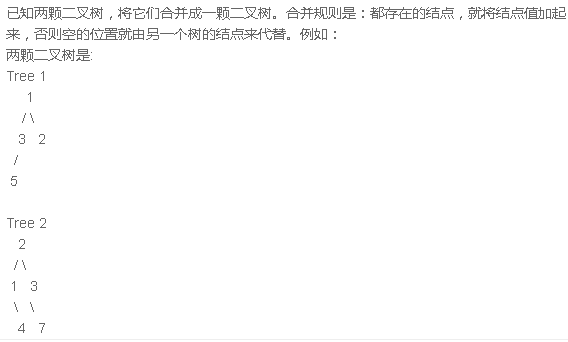
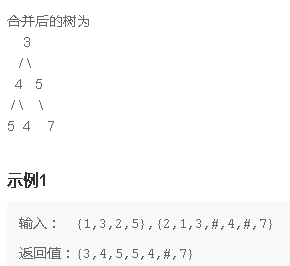
public class Solution { /** * * @param t1 TreeNode类 * @param t2 TreeNode类 * @return TreeNode类 */ public TreeNode mergeTrees (TreeNode t1, TreeNode t2) { if (t1 == null && t2 == null) return null; if (t1 == null || t2 == null) return t1 == null ? t2 : t1; // 此时 t1、t2 均不为 null // 合并节点的值 t1.val = t1.val + t2.val; // 合并左子树 t1.left = mergeTrees(t1.left, t2.left); // 合并右子树 t1.right = mergeTrees(t1.right, t2.right); return t1; } }
2、NC161 二叉树的中序遍历
public int[] inorderTraversal (TreeNode root)
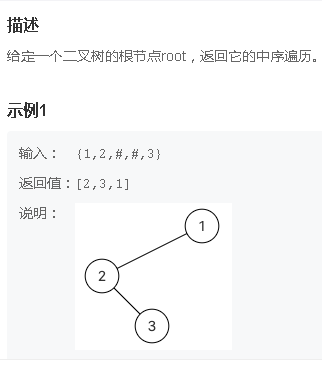
解法1:递归
public class Solution { // 中序遍历的递归写法 思路清晰但是不够高效 ArrayList<Integer> list = new ArrayList<>(); public int[] inorderTraversal (TreeNode root) { recur(root); return list.stream().mapToInt(Integer::valueOf).toArray(); } public void recur(TreeNode root) { if (root == null) return; recur(root.left); list.add(root.val); recur(root.right); } }
解法2:非递归(往左找,出栈往右找)
public int[] inorderTraversal (TreeNode root) { ArrayList<Integer> arrList=new ArrayList<>(); Stack<TreeNode> stack=new Stack<>(); while(root!=null || !stack.isEmpty()){ while(root!=null){ stack.push(root); root=root.left; } root=stack.pop(); arrList.add(root.val); root=root.right; } return arrList.stream().mapToInt(Integer::valueOf).toArray(); }
3、NC72 二叉树的镜像
public TreeNode Mirror (TreeNode pRoot)
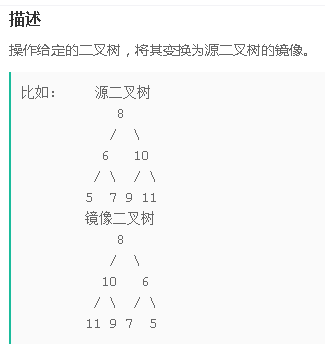
public TreeNode Mirror (TreeNode pRoot) { if(pRoot == null) { return null; } if(pRoot.left == null && pRoot.right == null) { return pRoot; } TreeNode L = Mirror(pRoot.left); TreeNode R = Mirror(pRoot.right); pRoot.left = R; pRoot.right = L; return pRoot; }
4、NC13 二叉树的最大深度
public int maxDepth (TreeNode root)
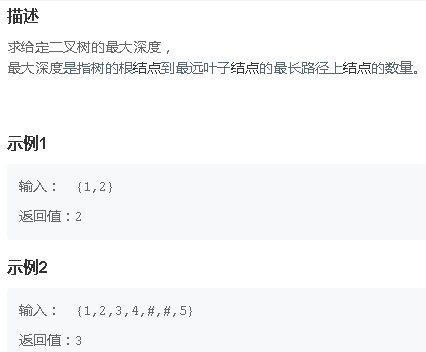
解法1:非递归-层次遍历+队列
public int maxDepth (TreeNode root) { //通过层次遍历计算二叉树的深度 if(root==null) return 0; Queue<TreeNode>queue=new LinkedList<>(); queue.offer(root); int level=0,size; while(!queue.isEmpty()){ size=queue.size(); for(int i=0;i<size;i++){ TreeNode node=queue.poll(); if(node.left!=null) queue.offer(node.left); if(node.right!=null) queue.offer(node.right); } level++; } return level; }
解法2:递归
import java.util.*; /* * public class TreeNode { * int val = 0; * TreeNode left = null; * TreeNode right = null; * } */ public class Solution { /** * * @param root TreeNode类 * @return int整型 */ public int maxDepth (TreeNode root) { if(root==null){ return 0; } int left = maxDepth(root.left); int right = maxDepth(root.right); return 1 + Math.max(left,right); } }
5、NC136 输出二叉树的右视图
public int[] solve (int[] xianxu, int[] zhongxu)
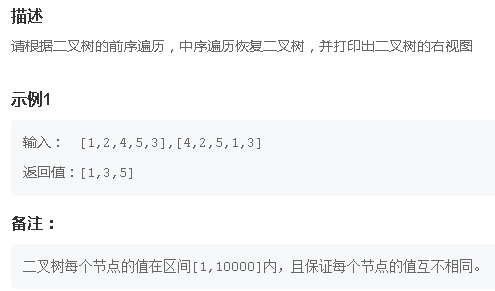
构造出二叉树之后再用队列找到每层的最后一个节点
HashMap<Integer,Integer> inOrderHashMap = new HashMap<>(); public int[] solve (int[] xianxu, int[] zhongxu) { // write code here if (xianxu==null||zhongxu==null||xianxu.length==0||zhongxu.length==0) return new int[0]; for (int i = 0; i < zhongxu.length; i++) { inOrderHashMap.put(zhongxu[i],i); } TreeNode root = buildTree(xianxu, 0, xianxu.length - 1, inOrderHashMap, 0, zhongxu.length - 1); Deque<TreeNode> queue = new ArrayDeque<>(); queue.offer(root); int[] res = new int[xianxu.length]; int count =0; while (!queue.isEmpty()){ //拿到当前层元素个数 int len = queue.size(); System.out.println(len); for (int i = 0; i < len; i++) { TreeNode node = queue.poll(); if (node.left!=null) queue.offer(node.left); if (node.right!=null) queue.offer(node.right); //到最后一个元素了 if (i==len-1) res[count++] = node.val; } } //count是有效数组元素 0下标开始 跟左闭右开刚好对冲 return Arrays.copyOfRange(res,0,count); } //inOrder: [inLeft,rootIndex-1] rootIndex [rootIndex+1,inRight] //preOrder: preLeft [preLeft+1,preLeft+rootIndex-inLeft] [preLeft+rootIndex-inLeft+1,preRight] private TreeNode buildTree(int[] xianxu, int preLeft, int preRight, HashMap<Integer, Integer> inOrderHashMap, int inLeft, int inRight) { //preLeft == preRight时 也要执行的 --叶子节点罢了 if (preLeft>preRight||inLeft>inRight) return null; int rootIndex = inOrderHashMap.get(xianxu[preLeft]); TreeNode root = new TreeNode(xianxu[preLeft]); root.left = buildTree(xianxu, preLeft + 1, preLeft + rootIndex - inLeft, inOrderHashMap, inLeft, rootIndex - 1); root.right = buildTree(xianxu,preLeft+rootIndex-inLeft+1,preRight,inOrderHashMap,rootIndex+1,inRight); return root; }
6、NC102 在二叉树中找到两个节点的最近公共祖先
public int lowestCommonAncestor (TreeNode root, int o1, int o2)
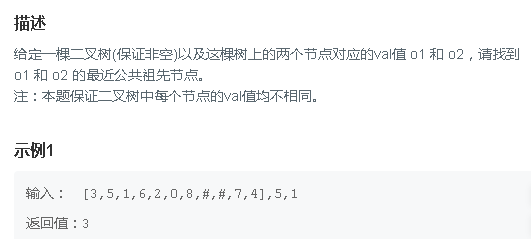
public int lowestCommonAncestor (TreeNode root, int o1, int o2) { // write code here if(root.val == o1 || root.val == o2){ return root.val; } TreeNode treeNode = order(root, o1, o2); return treeNode.val; } public TreeNode order(TreeNode root, int o1, int o2){ if(root == null) return null; if(root.val == o1 || root.val == o2) return root; TreeNode left = order(root.left, o1, o2); TreeNode right = order(root.right, o1, o2); if(left != null && right != null) return root; if(left == null && right == null) return null; return left == null? right: left; }
7、NC15 求二叉树的层序遍历

原文:https://www.cnblogs.com/liujinhui/p/15134973.html